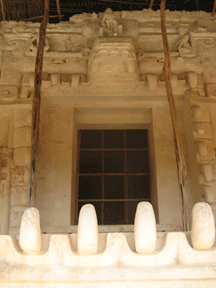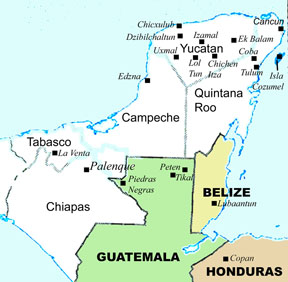Mayan Civilization’s Collapse: Deforestation
Does this sound familiar? Although this quote is excerpted from a Live Science article about the
ancient Mayan civilization in the rain forests of Guatemala, the reference to tree pollen being replaced by weed pollen sounds a lot like our present civilization.
I live in a rural area in the U.S., and everywhere around me, forests are being cut down to create subdivisions.
From pollen trapped in ancient layers of lake sediment, scientists have learned that around 1,200 years ago, just before the civilization’s collapse, tree pollen disappeared almost completely and was replaced by the pollen of weeds. In other words, the region became almost completely deforested.
Aren’t we cutting down trees and replacing them with cities, farms, and industrial regions? Don’t most of us live in areas where tree pollen hardly exists any more?
The above quote refers to the ancient Mayan civilization in the Peten region of Guatemala. According to a Live Science article, Ancient Mayan Canals Possibly Spotted in Satellite Images, NASA climate scientist Bob Ogelsby at the Marshall Space Flight Center, learned from computer simulations that:
Without trees, erosion would have worsened, carrying away fertile topsoil. The changing groundcover would have boosted the temperature of the region by as much as 6 degrees, . . .
The article goes on to say that the basic cause of the Mayan civilization’s collapse was because of ongoing food and water shortages brought on by a “combination of natural drought and deforestation by humans.” Could we be creating our own civilization’s collapse by deforesting our land? Can we learn from the ancient Maya?
From my point of view, the most important thing has to do with the disregard for our dependence on the nature kingdom.
Continue readingAtlantis past life memories like Mayan Ruins

The Mayan Monster Mouth at the entrance to the tomb in the pyramid at Ek Balam. Photo courtesy of Miriam Balsley, used with permission.
This is the first time I’ve seen a scientist saying that the Mayan monster mouth sculpture symbolizes the entrance to the underworld.
All along, during my travels in Yucatan searching for corroboration of my memories of Atlantis, I’ve been wondering if the monster mouth was actually a large serpent mouth, the kind I fell into in my Atlantis past life memories. I describe my scariest memory of Atlantis in both When We Were Gods and also Arrival of the Gods in Egypt.
In other words, I wonder if the monster mouth sculptures were made by the ancient Maya as a handed down memory of visits from Atlanteans to Yucatan.
In my Atlantis past life memories, a huge serpent mouth was sticking out of the earth as if it was the entrance into the underground. It’s always baffled me that after I fell into the serpent mouth, I was next flying through space from a crumbling Atlantis to geologically safe lands.
This article is very exciting, because the scientists say they believe the monster mouth represented an entrance into the underworld, just as I’d experienced in my past life regression. It also asserts my assertion that many of the Mayan myths are actually handed down memories of the colonization of Yucatan by people from Atlantis.
Take a look at this article on the discovery of a couple of new ruin sites in southern Mexico, Two ancient Mayan cities found in Mexican jungle.
It’s especially exciting because of the following paragraphs:
They also found a facade featuring a monster-mouth doorway, which probably marked one of the main entrances to the center of the city. Photographs from the sites showed stone pyramids jutting out from beneath dense foliage.
“The entrance apparently symbolizes the entrance to a cave and to the underworld … “
Continue reading
Lovely Turn Out at the Edgar Cayce Forum
I feel so happy that so many people came to hear my talk The Yucatan Connection to Atlantis and Lemuria Using Cayce Clues and Mythology at the Edgar Cayce Forum last night. It meant a lot to me that people came out even though it was a wild and stormy night. My feet got soaked walking into Edgar Cayce’s A.R.E. because of the rivulets of rainwater! I also felt so happy to see some friends who came to support me. Plus, I feel grateful for the help I received from the A.R.E.’s audio-visual person, Kevin, for his help in setting up my Powerpoint presentation.
Continue readingLooking Forward to Working on Tulum
Today, I continue editing the Tulum section of the Yucatan Travel Movie. It is a delight because the footage on Tulum is infused with gorgeous palm-swaying seascapes among the ancient Mayan ruins as well as images of the ancient Maya’s mythological gods Izamna and the Dios Descendante, the Descending God.
Continue readingCozumel Also a Great Diving Destination
Besides being one of the most sacred places for the ancient Maya, Isla Cozumel is a great destination for snorkellers and deep sea divers. When we were there a year ago, people were snorkelling beside an outdoor seaside restaurant, images of which will be in the Yucatan Travel Movie.
Continue readingApparition of the Blessed Virgin Mary in Izamal
Another fantastic day working on the Yucatan Travel Video. I love remembering my visits to the wonderful colonial town of Izamal where the town’s people, modern-day Maya, live among the ancient Mayan ruins . Alas, an overzealous Spanish bishop, during the time of the Spanish Inquisition, dismantled one of the pyramids and used its stones to construct a convent. Obviously, the location is a powerful sacred site. As it turns out, the statue of the Blessed Virgin Mary at this convent is attributed with having been an apparition because legend has it that the statue could not be moved from the convent. When we were there in December, the town had a huge celebration on her behalf complete with a carnival, a procession, and refreshments stands. Pope John Paul II made a pilgrimmage to the site.
Continue readingImages of Itzamna
Here’s a link to a number of images of Itzamna, the great god of the ancient Maya: http://images.google.com/images?q=itzamna&sourceid=ie7&rls=com.microsoft:en-US&oe=utf8&um=1&ie=UTF-8&ei=4HLFStLoM4ee8AaSpKQ5&sa=X&oi=image_result_group&ct=title&resnum=4
He is usually toothless, sits in a lotus position, sometimes has a beard – very unusual since the pure blooded Maya do not have beards. Verrry interesting.
Today, I am including the search for an image of Itzamna at Chichen Itza in the Yucatan Travel Movie.
Continue readingYucatan Travel Video Includes Itzamna
Itzamna was a very important god of the ancient Maya. He is one of their founder gods who oversaw all the other gods.
Carol Chapman
Continue readingDecember 21, 2012 Date Uncertain
As I’ve said before in this blog, and as I say in my lectures on, “2012, Edgar Cayce and the Maya,” the December 21, 2012 date has changed a number of times.
The change in date is the result of developments in the translation of ancient Mayan glyphs, the written language of the ancient Maya. The Mayan glyphs have only recently been translated by archeologists and linguists.
Modern-day Maya do not know how to read the ancient Mayan glyphs. Although many modern-day Maya speak their traditional language, they virtually lost their written language when Bishop Diego de Landa, fired with Spanish Inquisition zeal, burnt all of their books on July 12, 1562. These books were one-of-a-kind, meticulously transcribed codices written by shamans similar to scrolls produced by monks. They were irreplaceable . . . and they are all, except for 3 codices and parts of a fourth, gone.
It has taken modern scholars a long time to decipher the unusual ancient glyphs. Once they had the dates translated, they had to correlate the dates they discovered with the dates of the calendar we use, the Gregorian Calendar. In the process, the date for the end . . . and subsequent beginning of the new . . . Mayan Long Count Calendar has changed a number of times.
At the present time, December 21, 2012 is the agreed upon date that has been correlated with the Gregorian calendar as the date was that translated from the ancient Mayan glyphs.
But don’t hold your breath. That date may yet change again.
Carol Chapman
Continue reading2012, Edgar Cayce and the Maya Update
I’ve been updating my PowerPoint presentation of 2012, Edgar Cayce and the Maya to include information from my recent visits to the Yucatan; namely, the Chichen Itza Pyramid of Kukulcan Equinox Event and the Chichen Itza Mayan Elders Equinox Ceremony.
The presentation will also include my photographs of the Milky Way’s Galactic Center, because the Earth and Sun will be exactly lined up with the Galactic Center on December 21, 2012 for the first time in 25,625 years.
2012, Edgar Cayce and the Maya will be presented in Comox, British Columbia, on May 28th, in Nanaimo, British Columbia, on June 4th and in Richmond, Virginia, on June 20th. For event particulars, including contact information, please click through to the Events Page on my speaker web site.
Copyright (c) 2009 Carol Chapman
Continue reading